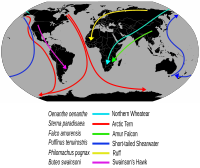
Photo from wikipedia
Migratory animals undergo seasonal and often spectacular movements and perform crucial ecosystem services. In response to anthropogenic changes, including food subsidies, some migratory animals are now migrating shorter distances or… Click to show full abstract
Migratory animals undergo seasonal and often spectacular movements and perform crucial ecosystem services. In response to anthropogenic changes, including food subsidies, some migratory animals are now migrating shorter distances or halting migration altogether and forming resident populations. Recent studies suggest that shifts in migratory behaviour can alter the risk of infection for wildlife. Although migration is commonly assumed to enhance pathogen spread, for many species, migration has the opposite effect of lowering infection risk, if animals escape from habitats where pathogen stages have accumulated or if strenuous journeys cull infected hosts. Here, we summarize responses of migratory species to supplemental feeding and review modelling and empirical work that provides support for mechanisms through which resource-induced changes in migration can alter pathogen transmission. In particular, we focus on the well-studied example of monarch butterflies and their protozoan parasites in North America. We also identify areas for future research, including combining new technologies for tracking animal movements with pathogen surveillance and exploring potential evolutionary responses of hosts and pathogens to changing movement patterns. Given that many migratory animals harbour pathogens of conservation concern and zoonotic potential, studies that document ongoing shifts in migratory behaviour and infection risk are vitally needed. This article is part of the theme issue ‘Anthropogenic resource subsidies and host–parasite dynamics in wildlife’.
Journal Title: Philosophical Transactions of the Royal Society B: Biological Sciences
Year Published: 2018
Link to full text (if available)
Share on Social Media: Sign Up to like & get
recommendations!